
The display developed soon after the snow guns were started at 21:30 and began vanishing no earlier than 05 in the morning when Ac clouds rolled over. It was an unusually stable display, the swarm stayed in the same location and there were no much changes in the halo composition.
Jari Luomanen ( 1 ) and Mika Aho ( 2 ) photographed the display and took videos in the spotlight beam. I sampled crystals ( 3 – 4 – 5 ). Wegener arcs were full and both lower Parrys were visible.
Diamond dust halos were observed also in Sievi by Marko Mikkilä ( 6 ) and in Hyvinkää by Jukka Ruoskanen ( 7 ).

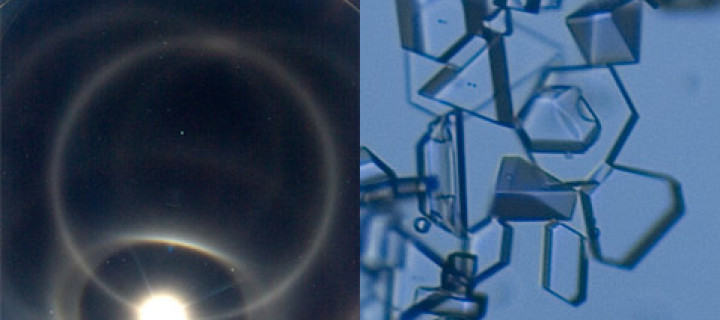
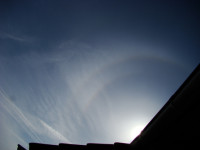
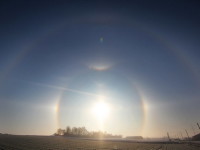
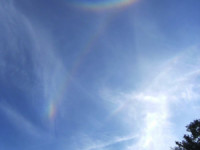
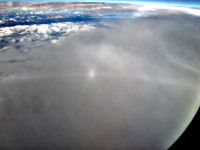
You guys hit the jackpot. This is what I call a halo display. Very impressive indeed.
That’s a mega-display, a full-sky show! And again I must emphasise how sharp those crystal photos are!
There is an error in my posting. The parry population is so strong, that Hastings must have contributed to the full Wegener. Maybe Hastings is even the major component.
Impressive display! Congratulations to all of you.
Jari, photos of this display on your site are marvellous! Good job.
WOW!!! Now thats what I’m talkin about both concave parrys both upper and lower wegeners how much better could it get??
Congrads to all.
Wow indeed…perigee moon, diamond dust, long exposures and you get a perfect display.
I think I saw reflected Lowitz arcs stretching all the way to 46 degree halo in one of the lamp display photos from Jari Luomanen, with some unsharp masking though.
Truly an amazing parry dominated display.
Same occurred to me as well (the reflows’). The outwards curving component this time. Maybe there is ghostly also the inwards curving component.
Reflected lowitz where do you see them.
I also noticed besides the upper and lower concave I also can see lower convex parry.
My favourite Jari’s photo is on SpaceWeather. Congrats again.
Jakub, thanks. I see they have now added Mika as well. Originally I submitted all of our names but for some reason Mika was at first left out of the published text. Just came home from work and had the time to concentrate on the space weather post.
Patrik Trncak made a note that it is actually Wegener arc in the display. He is right, simulations confirm that, also in the lamp beam it is Wegener arc. Hastings may be contributing, but it is minor contribution.
I don’t know but in the lamp display I can see seperation between wegener and hastings arcs. You san see seperation where the arcs end away from the light.
Speaking of Patrik Trncak I can never email him even though I use the address on his homepage.
Jukka, I especially like your cable halo. Another intriguing case after those photographed by Jari last year.
Yeah, Ágnes, the cable halo was fun to look at as it changed its shape smoothly as one started walking. The Moon light that is reflecting from the cable seems to produce at least one kind of colourless halo and one with prismatic inner edge. Maybe the colourless one arises from parhelic circle or pillar (?) raypath and the coloured one from 60 degree wedge. I haven’t got time to do any ray-tracing, but in the future I’ll surely write a code to examine this funny halo.
Cable halo? Which photo Jari I like to see that. Show me which photo that is showing the halo tube around cable.
Cable halo – I suppose this – (1)
I think Jukka is talking about this photo:
http://www.kolumbus.fi/jukka.ruoskanen/Halot/090109/images/Kaapeli.jpg
Jakub is correct, that’s the cable halo. I also shot some video footage of the halo a few weeks ago and will upload them at some point.
This looks almost unreal..can’t wait to see it online.
Wow that halo tube photo is very bizzare I have never seen anything like it before in the world of halos. Could you see this visually, or did you have to do exposure?
It was easy to see visually. In fact, I was driving by (hunting halos of course) and just had to slam the brakes when I first saw this. Needless to say, I was at first thinking that my eyes are playing tricks on me but luckily that was not the case.
Yes, the cable halo was visually very impressive. Strange things come about when the light source is not a point or the light rays parallel.
Here’s some footage.
The cable halo.
I have no idea why the online flash player seems to hang in the beginning. The original file is OK. I’ll see what I can do about it.
For whatever reason (the online video world seems riddled with bugs) it plays better here. Be sure to click the “watch in high quality” link.
Wow video is amazing I never seen anything like that!! I wonder if you reflect light off any surface would it do something like that. Try a shiny steel pipe or a convex mirror who know what you will see. Speaking of youtube type atmospheric halos and hit search.
Michael, yes, I’m sure any thin, long reflective object would produce this.
At some point in desperation I visioned that maybe the crystals were oriented azimuthally due to some electric field near the cable, but I suppose that’s such a far out idea that the less is said about it the better. 🙂
Anyway, my hat’s off to the guy or gal who cracks this first.
Here are some better images of the cable halo (better than the ones embedded in my first post the other winter). The links in the first cable halo post will not work as I have migrated my galleries onto a new server. I know, I should update all the links but right now I cannot ever bear the though of the hassle.
This is great stuff. Were the sky so blue actually ?
Nope, I don’t know what type of lamps they use there but my default – the daylight white balance – gave me a rather sickly color cast. Hence I tweaked it more to my liking in the RAW conversion. I prefer bluish tones so that’s the result. The halos were quite monochromatic.
Incidentally, the place where this was shot is kind of funny as there are all sorts of floodlights around and almost every single one of them seems to be of different color temperature and color cast. There are deep orange, yellowish, greenish and bluish lamps around. It makes for a psychedelic shooting experience. 🙂
Here’s another shot from the same area.
The cable halo lamp is like the one just outside the upper left corner. The one that generates superparhelia. It’s one of the several similar floodlights around there. Against the background that is mostly leaning towards tungsten white balance it appears slightly greenish/bluish.